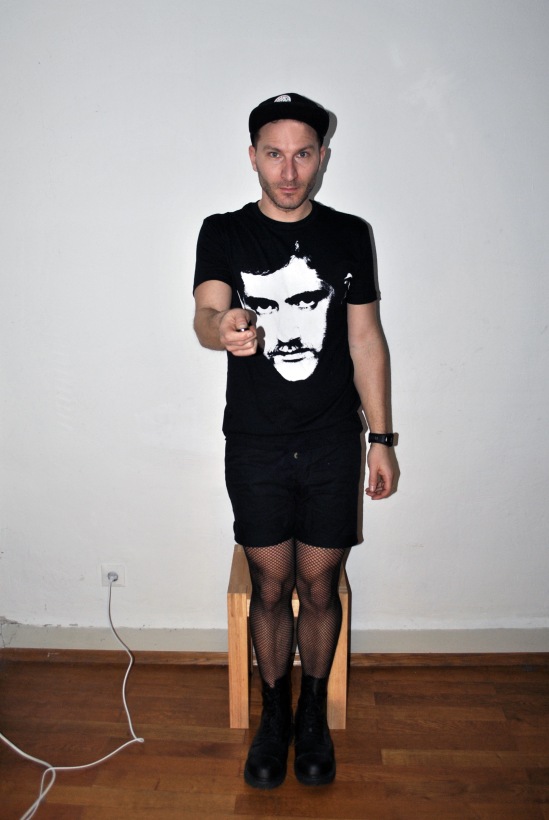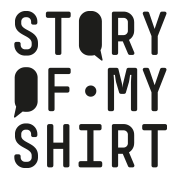scroll down for english version!

Wann und wo hast du das ausgewählte Kleidungsstück gekauft?
Das Shirt habe ich im letzten Jahr im Online-Shop des kalifornischen Schallplattenlabels Dark Entries Records bestellt. Und eine Woche nachdem es per Post ankam und ich mich in Design, Druck & Passform verliebt hatte, habe ich es gleich noch ein zweites Mal bestellt.
Warum hast du es für dieses Porträt ausgewählt, was macht es so besonders für Dich?
Da muss ich jetzt ein wenig ausholen. Auf dem Shirt ist das Portrait von Patrick Cowley zu sehen, ein amerikanischer Musiker & Produzent und für mich eine Ikone und Leitfigur schwuler Tanzmusik. Zusammen mit Sylvester hat er in den späten 70ern und frühen 80ern HiNRG-Hits wie „Do you wanna funk“ oder „Menergy“ produziert. Manch einer kennt vielleicht auch seinen 15-Minuten Remix von Donna Summers „I feel love“. Seine Musik bedeutet mir sehr viel, trotz oder gerade wegen ihrer Schwülstigkeit und ihrem überbordenden Hedonismus, der in einem krassen Spannungsverhältnis zu der Situation der Gay-Community in den frühen Achtzigern steht. Das war ja eine ziemlich dunkle Zeit. Soziale Ausgrenzung & Stigmatisierung, gewalttätige Übergriffe, die ersten AIDS-Fälle und die damit verbundenen Unsicherheiten und Ängste. Cowley gehörte dann auch gleich zu den ersten prominenten AIDS-Toten, er verstarb bereits 1982 mit 31 Jahren. Kaum auszudenken, was da musikalisch noch möglich gewesen wäre.

Torben aka Sergeant Pfeffer
Gibt es ein Erlebnis, das Du damit verbindest? Welches?
Neben allem oben bereits gesagten, mag ich sehr gerne, wie dieses Shirt in mein Leben kam. Aufmerksam darauf wurde ich durch einen Facebook-Post der von mir sehr geschätzten Marea Stamper a.k.a. The Black Madonna. The Black Madonna ist eine Musikerin & Produzentin aus Chicago. Ich bin nicht nur Fan ihrer Musik und die Art, wie kreativ und zwingend sie als DJ mit dem immensen Archiv amerikanischer Housemusik umgeht, sondern vor allem auch ihren Style und ihre Idee von sozialer Gerechtigkeit und Community-Building. Marea widersetzt sich vehement gängigen Lookismen & einem Status Quo, der Tanzmusik an einen Idealtyp des weißen, jungen & unbekümmerten Mannes koppelt. Auf ihrer Facebook-Seite schreibt sie eine Art kleines Manifest, das einen ganz guten Einblick in ihre Idee von Tanzmusik gibt:
„Dance music needs riot grrrls. Dance music needs Patti Smith. It needs DJ Sprinkles. Dance music needs some discomfort with its euphoria.Dance music needs salt in its wounds. Dance music needs women over the age of 40. Dance needs breastfeeding DJs trying to get their kids to sleep before they have to play. Dance needs cranky queers and teenagers who are really tired of this shit. Dance music needs writers and critics and academics and historians. Dance music needs poor people and people who don’t have the right shoes to get into the club. Dance music needs shirts without collars. Dance music needs people who struggled all week. Dance music needs people that had to come before midnight because they couldn’t afford full admission. Dance music does not need more of the status quo.“
Das ist ein Ansatz, der mich tatsächlich sehr berührt, weil er als klare Absage an die oftmals üblichen Lifestyle-Plattitüden des globalen Elektronik-Jet-Sets zu verstehen ist. Marea bespielt eine Tanzfläche, auf die sie vor allem auch die Außenseiter lädt. In diesem Sinne sehe ich ihre Shirt-Wahl natürlich auch als Statement. Wenn ich mein Patrick-Cowley-Shirt trage, dann will ich es in ihrer Tradition tragen. Radikal inklusiv, mit einem positiven Vibe und einer ordentlichen Portion Groove in den Hüften.

Wie würdest Du Deinen Stil beschreiben?
Am liebsten gar nicht. „Ain’t got no style, I’m strictly roots“. Aber im Ernst: meinen Stil würde ich als eher minimal bezeichnen. Casual Queer with tiny sprinkles. Netzstrümpfe trage ich mittlerweile auch nur noch bei Hochzeiten, Notarztterminen oder Blogfeatures, also eher nicht in meinem Alltag. Ich habe 3 graue Hosen, 10 schwarze Shirts, 4 schwarze Pullis, alle in identischer Größe & vom gleichen Hersteller. Ich neige dazu, mir länger Gedanken über ein bestimmtes Kleidungsstück zu machen. Habe ich dann mal die für mich ideale Passform & Silhouette gefunden, kaufe ich auch gerne mehrmals. Und damit das alles nicht zu sehr uniform wird, wird hier und da ein wenig editiert. In meinen Zwanzigern trug ich jahrelang nur weiße Unterhemden, auf die ich mit schwarzem Edding die Namen von Lieblingsbands und Sehnsuchtspolen gekritzelt habe: House Music. Sleater Kinney. Pet Shop Boys. Aus meinen schwarzen Pullis ist überall feinsäuberlich der Kragen rausgeschnitten. Dazu gibts dann ab und an ein Accessoire. Das Cowley-Shirt. Oder ein Shirt von Rudy Loewe. Oder Strumpfhosen. Je nachdem, was die Mission des Tages eben von einem verlangt, Bondgirlism oder Raubtierdressur. Ich bin da einigermaßen flexibel.
Was trägt das Kleidungsstück dazu bei, diesen Stil zu kreieren?
Es macht, was ich sehr gerne mag: Es verknüpft Themenfelder und macht Platz für ein Gespräch. So kam es ja zum Beispiel auch zu diesem Interview. Das Shirt erzählt jede Menge Geschichten, von Minderheiten & Verletzlichkeiten, aber unbedingt auch von Stolz und überbordender Lebensfreude. Und nicht zuletzt ist es auch einfach ein schönes Kleidungsstück, das sich gut anfühlt und das ich sehr gerne trage.
Torben aka Sergeant Pfeffer schreibt einen Blog Rezeption – dort geht es um „Wut und Mut und Schönheit. Um Meinungen, Tendenzen, Streiterei, Ober- und Unterflächlichkeiten.“ Im richtigen Leben macht er Marketing Kram für die Kantine Konstanz, ein Club, den ich dringend mal aufsuchen muss, denn dort wird wohl regelmäßig gepflegt durchgedreht.
Ich wollte Torben in der Serie haben, weil mir sein T-Shirt auf einer Party aufgefallen war und wir darüber ins Gespräch kamen. Als er mir die Fragen beantwortet hatte, war ich sehr berührt, denn merkwürdigerweise -obwohl es um ihn ging- habe ich mich gesehen, verstanden und gehört gefühlt. Danke dafür.
english version
When and where did you buy your chosen piece of clothing?
I ordered this shirt last year in Dark Entries Records’ online shop, which is a californian record label. And a week after it arrived and I had totally fallen in love with the design, printing and fitting of the shirt, I ordered a second one.
Why did you choose it, what makes it so special to you?
To answer this question I need to explain a little more: Printed on the shirt you can see the portrait of Patrick Cowley, an american musician & producer, who is an icon to me and a leading figure in gay dance music. Together with Sylvester he produced HiNRG-Hits like „Do you wanna funk“ or „Menergy“ in the late 70ies and early 80ies. Some of you might know his 15-minute Donna Summer „I feel love“ remix. His music means a lot to me, despite – or maybe because of – its’ cheesieness and its’ overwhelming hedonism which contrasts sharply with the situation the gay community was in in the early 80ies. That was a pretty dark time. Social exclusion & stigmatization, violent attacks, first AIDS cases and all the anxieties and fear that comes with it. Cowley was one of the first public figures to die of AIDS, he passed away in 1982 already, aged only 31. I don’t even want to think about what he still could have achieved musically.
Is there a certain story connected with the shirt? Which one?
Besides everything I’ve already mentioned, I like the way this shirt came into my life. It caught my attention through a facebook post by Marea Stamper a.k.a. THE BLACK MADONNA, who I adore. The Black Madonna is a musician & producer from Chicago. Besides being a fan of her music and the creative and forceful way she handles the massive archive of american House Music, I especially love her style and her idea of social justice and community building. Marea vehemently opposes common look-ism & and a status quo which connects House Music with the ideal of the white, young & careless male. She has sort of a little manifesto on her Facebook page which gives you a glimpse into her idea of dance music:
„Dance music needs riot grrrls. Dance music needs Patti Smith. It needs DJ Sprinkles. Dance music needs some discomfort with its euphoria.Dance music needs salt in its wounds. Dance music needs women over the age of 40. Dance needs breastfeeding DJs trying to get their kids to sleep before they have to play. Dance needs cranky queers and teenagers who are really tired of this shit. Dance music needs writers and critics and academics and historians. Dance music needs poor people and people who don’t have the right shoes to get into the club. Dance music needs shirts without collars. Dance music needs people who struggled all week. Dance music needs people that had to come before midnight because they couldn’t afford full admission. Dance music does not need more of the status quo.“
This is something that really moves me because it is a very clear ‚no‘ to the usual lifestyle platitudes of the electronic jet set. Marea plays her music for a dance floor onto which she explicitly invites the misfits. In this context I see her choosing that T-shirt as a statement. Whenever I wear my Patrick Cowley shirt I wear it in her tradition: radical inclusivity, with a positive vibe and a big portion of groove in the hips.
How would you describe your own style?
I would prefer not to. „Ain’t got no style, I’m strictly roots“. But seriously: I would describe my style as minimalistic. Casual Queer with tiny sprinkles. Meanwhile I only wear fishnet stockings for weddings, appointments with solicitors or blog features – meaning not really in my daily life. I have 3 pairs of grey pants, 10 black shirts, 4 black jumpers, everything in the same size and from the same label. I tend to think longer about a certain piece of clothing. Once I found the right size & silhouette, I am likely to buy it several times. And to keep it from becoming a uniform, I edit it here and there. In my twenties I wore white vests for years onto which I had written the names of my favorite bands and desires in black marker: House Music, Sleater Kinney, Pet Shop Boys. I very precisely cut out the collars of all of my black jumpers. On top of that I combine it with an accessory once in a while. The Cowley-Shirt for example or Rudy Loewe shirt. Or fishnet stockings. It depends on the mission of the day: bond girlism or taming wild animals. I’m quite flexible when it comes to that.
In which way does the chosen piece of clothing help to create that style?
It does something I really like: it connects topics and makes room for a conversation. This is how this whole interview started. The shirt tells a lot of stories about minorities & vulnerabilies but also about pride and an exuberant joy of life. And last but not least it is simply a beautiful piece of clothing that feels good and that I enjoy wearing.

„Als er mir die Fragen beantwortet hatte, war ich sehr berührt, denn merkwürdigerweise – obwohl es um ihn ging – habe ich mich gesehen, verstanden und gehört gefühlt. Danke dafür.“ Das ist ungefähr das größte Kompliment, das du mir machen kannst, liebe Alex. Genau darum gehts ja: love&community.
LikeGefällt 1 Person
Ich finde es wahnsinnig schön, wie Torben die Strumpfhosen trägt! Wenn der Blick von oben nach unten gleitet, ist es unerwartet, aber einfach so… stimmig! Seine spitzbübische Widerständigkeit im Blick finde ich so wunderbar sympathisch. Und sein Kleidungsstil? Der bestätigt das noch. Danke für deinen Mut, so zu sein, wie du bist und sein willst! Du bist eine Inspiration.
LikeGefällt 1 Person
Vielen Dank Vivien! Much appreciated!
LikeLike
Pingback: The story of my shirt | REZEPTION